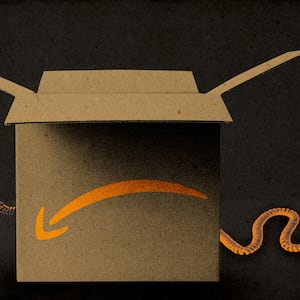Last Sunday morning, I woke up to a message in my friends’ group chat with a link to the Saturday Night Live skit “Fashion Coward.” It was a parody commercial for a store that caters to people who hate shopping. At Fashion Coward, customers can easily buy “clothes that suggest the general idea of a person.”
Racks are stocked with “brown sweaters, navy shirts, pants for the leg, and one black dress that says, ‘Keep it moving.’” The joke’s punchline is “It’s just Ann Taylor,” an easy jab at the much-maligned chain of business-casual basics.
But Ann Taylor has some competition in Amazon, where women flock to purchase utilitarian, good-enough clothing with as much passion as they would buying a new toilet brush.
The megaretailer's foray into capital-F fashion has been tricky. Despite attempts like glossy Vogue advertisements and the implementation of the try-before-you-buy program Amazon Wardrobe, the behemoth has failed to endear itself to industry insiders.
But Amazon has carved out a healthy niche in... well, no offense, but Fashion Cowards. The anti-peacocks among us who view what they put on their bodies as just another thing to buy, like a coffee maker or touchless garbage can, can visit the site to purchase “essentials.” (Representatives for Amazon Fashion declined The Daily Beast's request for interview.)
“A lot of people are not necessarily comfortable making fashion decisions,” Tyler McCall, deputy editor of Fashionista, told The Daily Beast. “That’s why we write trend wrap-ups, or the five things to buy at Zara this month to help people make the decision. The same reason I need somebody to tell me how to buy a vacuum cleaner, people want to know how to find a good winter coat that’s not $3,000.”
Amazon’s quiet sartorial coup started, in fact, with a coat. Or rather, The Coat, as the $137 Orolay Women’s Thickened Down Jacket has become known.
In March 2018, Katy Schneider of New York’s revenue-generating commerce site The Strategist, wrote a short post called “The Unlikely Tale of an Amazon Coat That’s Taken Over the Upper East Side.”
Women who lived or socialized with those from the ritzy neighborhood spoke of the coat’s mind-boggling appeal. “I went to a Soulcycle on 83rd and I was one of four people wearing it,” Ana Maria Pimentel, the fashion director at Neiman Marcus, told the site. “Seven of my super-close friends have bought it since. A woman at a department store literally bought it on her phone, right in front of me.”
Relatively cheap, with two-day shipping, trendy zippers and puffing that some said looked expensive, The Coat quickly went viral. CNBC dubbed it a “must-have.” Influencer Arielle Charnas endorsed it to her million followers.
As Vox’s Rebecca Charnas wrote in a piece about The Coat-related mania, one Glamour headline, ‘Everyone you know is buying the Amazon coat’ “sounded somehow like a threat.”
With the changing of seasons and shedding of coats come new ‘The’-prefaced pieces about items of Amazon clothing. InStyle profiled The Dixperfect One Piece: $27, boasting over 1,000 reviews, and the title of “universally-flattering.”
Just this week People boasted about finding “The ‘Holy Grail’ of Yoga Pants,” a $25 pair of black “tummy control” leggings.
Glamour spotted The Bra, a $68 Natori number with a “cult” following that even includes Lady Gaga, herself a noted one-woman fashion week and a follower of nearly nothing.
The items all have product names long enough to rival a breathless James Joyce sentence. For instance, the one-piece's legal name is: Dixperfect Women's Retro 80s/90s Inspired High Cut Low Back One Piece Swimwear Bathing Suits. The word scramble is a hodgepodge of things you're likely to search, ensuring easy access to those who prefer to shop online.
Along with fitting into Google's algorithm, the clothing follows a similar visual equation. It's cheap, but could look expensive, simple, and comfortable. Definitely not unstylish, but mindlessly designed as to guarantee wherever you wear the goods will be the path of least compliments.
Entirely unexceptional—and that is the point. Let’s cover and lift up “the girls,” as the Dixperfect One Piece promises to do, and move on with our lives.
Channing Hargrove, fashion news writer for Refinery29, told The Daily Beast that she is a frequent Amazon shopper. (It doesn't hurt that she sits next to her site’s market writer, who often sends her links to new finds.)
“Yesterday I searched for a ‘rhinestone belt,’ read the reviews, and picked the one I bought that way,” Hargrove said. “I feel like the reviews are important—those are like instant feedback, like being in a dressing room with someone.”
Last year, a handful of famous models like Hailey Baldwin and Kendall Jenner inexplicably decided to wear ’90s bicycle shorts out in the world. Women's fashion sites started to call the tricky trend A Thing. Before plunging into the world of designer spandex, Hargrove turned to Amazon.
“I knew it was trendy, but I didn't know if I was in love with it,” she said. “I decided to try bicycle shorts out, quietly order a bunch of cheap pairs with the best reviews on Amazon, to decide if I liked it or not.”
The test dive approach used to be reserved for fast fashion chains like H&M and Forever21, where women can decide whether or not they look good in imitation Yeezy bodycon dresses without spending $900.
But that requires the emotional energy it takes to trudge to a store, wait in line for a dressing room, and stare at yourself naked under less-than-flattering fluorescent lights.
“Amazon is easier, because you can do it from your bed, on your phone,” Hargrove said. “When you’re at dinner with your friend who has a great necklace on, you can order that necklace and get it in two days.”
Analysts predict Amazon retail will be worth somewhere between $45 to $85 billion by 2020. The site's fashion conquest began in 2002, when its marketplace first started selling clothes. Seven years later in 2009, Amazon purchased Zappos, at the time its biggest competitor, for a whopping $850 million.
For years, Amazon Fashion kept stock of what its shoppers wanted—and were searching—resulting in a lineup of mid-priced labels like Kate Spade, Calvin Klein, Lacoste, and Levi Strauss. In 2016, the company began to quietly sell a handful of its own new, private lines.
At the time, WWD reported that one of the Amazon brands, Lark & Ro, had the mission statement: “Our purpose is to simplify your life by serving up effortless style when you need it most.” One year later, Amazon Fashion tapped Christine Beauchamp, who led teams at Victoria's Secret, Ann Taylor, and Ralph Lauren, as president.
Last month, a report from the data analytics company CoreSight Research found Amazon Fashion to be the most-shopped apparel retailer in the United States, unseating Walmart as number one.
Another deep dive from the investment bank Piper Jaffray listed Amazon as the most popular shopping website for teens. Fifty percent of those surveyed said they shopped on the site, above Nike, Urban Outfitters, and American Eagle.
But whether all that cash can buy clout remains to be seen. Charcy Evers, a fashion and retail trend analyst based in New York, told The Daily Beast that she has low expectations for the budding behemoth.
“I don’t see this going beyond the basics, the white T-shirts, with Amazon being a player in the fashion space,” Evers said. “The customer that’s most on Amazon is probably buying a utilitarian thing, like an electric broom, who thinks, ‘I might as well go over and get a pair of leggings as well.’”
As the issue of “sustainability” becomes less of a buzzword and an attempted industry-wide movement, Amazon could face increasing opposition.
Evers predicts: “We all have access to so much stuff, and what's going to rise to the top are unique, individual designers who make a statement, stand for something, advocate for causes beyond the clothing you wear.”
But until then, everyone is buying this $25 T-shirt dress.


